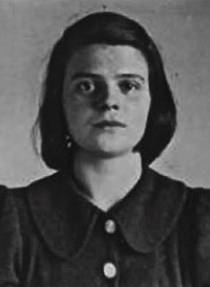
FAQ About Sophia Magdalena Scholl

Who was Sophia Magdalena Scholl?
Sophia Magdalena Scholl was a German student and anti-Nazi political activist, renowned for her role in the White Rose non-violent resistance group. She was born on May 9, 1921, and became one of the most prominent members of the movement, which aimed to awaken and encourage passive resistance against the Nazi regime during World War II.

What was the White Rose movement?
The White Rose was a non-violent resistance group in Nazi Germany, which was led primarily by a group of students from the University of Munich, including Sophia Scholl. Founded in 1942, the movement sought to spread awareness about the atrocities committed by the Nazi government, distributing leaflets calling for passive resistance against the war effort.

How did Sophia Scholl become involved in anti-Nazi activities?
Sophia Scholl's introduction to the White Rose movement came through her brother, Hans Scholl, who was also a founding member. Influenced by her Christian beliefs and a strong sense of justice, Sophia was drawn to their efforts to speak out against the oppression and violence of the Nazi regime. She actively participated in distributing leaflets that criticized Nazi policies.

What did the White Rose leaflets contain?
The leaflets produced by the White Rose covered various subjects, including the moral and political framework compelling opposition to the Nazis, detailed accounts of Nazi crimes, and calls to action for German citizens to resist the regime's policies. The leaflets were aimed at intellectuals and sought to galvanize the German population into resisting Adolf Hitler's regime.

How did Sophia Scholl and the White Rose group distribute their leaflets?
The White Rose group, including Sophia Scholl, distributed their anti-Nazi leaflets secretly to avoid detection. They left them in publicly accessible places such as telephone booths and university lecture halls, and also mailed them to random addresses. Their methods were designed to ensure the leaflets reached a wide audience without directly exposing the distributors to immediate risk.

What led to Sophia Scholl's arrest?
Sophia Scholl and her brother Hans were arrested on February 18, 1943, after being seen distributing White Rose leaflets at the University of Munich. A university janitor reported their actions to the Gestapo, the official secret police of Nazi Germany, leading to their detainment and the eventual capture of other group members.

What were the consequences of Sophia Scholl's actions?
After her arrest, Sophia Scholl, alongside other White Rose members, was tried by the People's Court under charges of treason. Despite the absence of proper legal procedures, she was sentenced to death. Sophia was executed by guillotine on February 22, 1943, at the age of 21.

Why is Sophia Scholl considered a symbol of resistance?
Sophia Scholl is celebrated as an enduring symbol of courage and moral conviction due to her brave and principled stand against the Nazi dictatorship. Her willingness to face extreme punishment for her beliefs has inspired generations to value freedom of speech and resist oppressive regimes.

How is Sophia Scholl remembered today in Germany?
Sophia Scholl is commemorated in Germany through various memorials, educational institutions, and cultural works. Streets and squares are named after her, and there is a commemorative white rose marker at the University of Munich. Schools, films, and books also honor her legacy and share her story with new generations.

Were there others involved with Sophia Scholl in the White Rose movement?
Yes, the White Rose movement included several individuals besides Sophia Scholl. Key figures included her brother Hans Scholl, Christoph Probst, Willi Graf, and Alexander Schmorell, among others. Together, they worked tirelessly to produce and distribute leaflets, risking their lives for the cause of resistance against Nazi tyranny.

What influences shaped Sophia Scholl's beliefs against the Nazi regime?
Sophia Scholl was deeply influenced by her Christian faith, a strong sense of conscience, and her family's political outlook which opposed Nazism. Her exposure to diverse philosophical and theological literature also helped shape her humanitarian beliefs and her conviction to actively oppose the Nazi regime.

What was the impact of Sophia Scholl's execution on German society?
Initially, Sophia Scholl's execution, along with that of other White Rose members, was intended as a warning to those considering resistance. However, in the post-war period, her story became a powerful symbol of the fight against tyranny and oppression. Her legacy encouraged post-war Germany to confront its past and uphold democratic values.

What educational backgrounds did Sophia and her associates have?
Sophia Scholl and many other White Rose members were university students. Sophia was enrolled at the University of Munich, where she studied biology and philosophy. This academic environment fostered critical thinking and engagement with ideas that were pivotal in forming the philosophical underpinnings of their resistance efforts.

How did the Gestapo respond to the White Rose activities?
The Gestapo, aware of the growing dissent expressed through the White Rose's activities, initiated a significant crackdown. They increased surveillance and pressed for leads among students and faculty in universities, leading to multiple arrests, including those of key members like Sophia Scholl and her brother Hans.

What role did Hans Scholl play in the White Rose?
Hans Scholl, Sophia's brother, co-founded the White Rose movement. As a medical student and former member of the Hitler Youth, Hans was pivotal in organizing the group, writing key leaflets, and coordinating efforts to secure resources for pamphlet distribution. He was a central figure in the group's strategy and actions.

Where did Sophia Scholl grow up?
Sophia Scholl was born and raised in the town of Forchtenberg in Germany. The Scholl family later moved to Ulm, where her father worked as the mayor. This peaceful upbringing, coupled with her family's anti-Nazi stance, helped mold her strong opposition to the oppressive regime.

What messages did the White Rose leaflets convey about the Nazis?
The leaflets contained messages denouncing the perceived injustices and moral failings of Hitler's regime, including its war policies, totalitarian nature, and human rights abuses. The texts encouraged Germans to oppose the regime through intellectual and moral resistance, calling for an awakening of the German conscience.

Why were the Scholl siblings executed by guillotine?
The Nazi regime used the guillotine as a method to execute individuals deemed threats to state security quickly and with a degree of public spectacle. The execution of Sophia and Hans Scholl by guillotine was intended as a deterrent to others who might consider acts of resistance, showcasing the harsh penalties under Nazi law.

What lessons does Sophia Scholl's story teach us about resistance?
Sophia Scholl's story is a lesson in moral courage, the importance of standing up for one's beliefs, and the power of individual action. It teaches that even under oppressive regimes, the acts of a few brave individuals can inspire change and uphold values of justice, truth, and humanity.

How did Sophia's religious beliefs influence her actions?
Sophia Scholl's Christian convictions played a significant role in her decision to resist the Nazi regime. Her faith instilled in her a strong moral compass and a belief in the sanctity of human life, which fueled her willingness to speak out against the injustices perpetrated by the Nazis, even at great personal risk.
